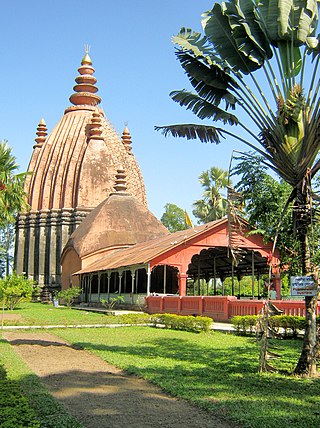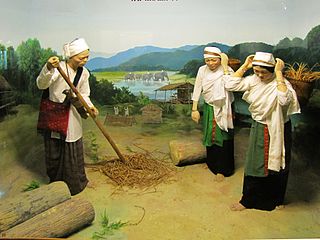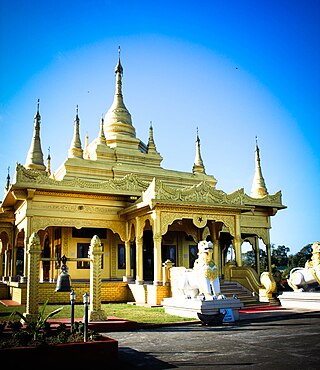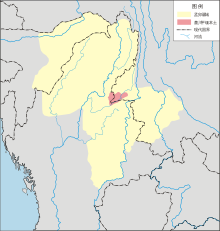
Assam is a state in northeastern India, south of the eastern Himalayas along the Brahmaputra and Barak River valleys. Assam covers an area of 78,438 km2 (30,285 sq mi). It is the second largest state in northeastern India by area and the largest in terms of population. The state is bordered by Bhutan and Arunachal Pradesh to the north; Nagaland and Manipur to the east; Meghalaya, Tripura, Mizoram and Bangladesh to the south; and West Bengal to the west via the Siliguri Corridor, a 22-kilometre-wide (14 mi) strip of land that connects the state to the rest of India. Assamese and Boro are the official languages of Assam. Meitei (Manipuri) is the official language of Hojai district and the entirety of the Barak Valley region, while Bengali is an official language in the three districts of Barak Valley.

The Shan people, also known as the Tai Long or Tai Yai, are a Tai ethnic group of Southeast Asia. The Shan are the biggest minority of Burma (Myanmar) and primarily live in the Shan State of this country, but also inhabit parts of Mandalay Region, Kachin State, Kayah State, Sagaing Region and Kayin State, and in adjacent regions of China, Laos, Assam and Meghalaya, Cambodia, Vietnam and Thailand. Though no reliable census has been taken in Burma since 1935, the Shan are estimated to number 4–6 million, with CIA Factbook giving an estimate of five million spread throughout Myanmar which is about 10% of the overall Burmese population.

The Ahom dynasty (1228–1826) ruled the Ahom Kingdom in present-day Assam, India for nearly 598 years. The dynasty was established by Sukaphaa, a Shan prince of Mong Mao who came to Assam after crossing the Patkai mountains. The rule of this dynasty ended with the Burmese invasion of Assam and the subsequent annexation by the British East India Company following the Treaty of Yandabo in 1826.
The Indian state of Arunachal Pradesh has a total population of roughly 1.4 million on an area of 84,000 km2, amounting to a population density of about 17 pop./km2. The "indigenous groups" account for about two thirds of population, while immigrants, mostly of Bengali/Hindi belt origin, account for the remaining third.

The Tangshang people or Tangsa Naga, are of Tibeto-Burmese ethnic group of the Arunachal Pradesh and Assam. They also reside in Sagaing Region and parts of Kachin State of Myanmar. In Myanmar they were formerly known as Rangpang, Pangmi, and Haimi. They speak their own language Tangsa.

Tinsukia is an industrial town. It is situated 480 kilometres (298 mi) north-east of Guwahati and 84 kilometres (52 mi) away from the border with Arunachal Pradesh.Tinsukia serves as the headquarters of the Moran Autonomous Council, which is the governing council of the Morans.

Sivasagar district, formerly known as Sibsagar, is one of the 34 districts of Assam state in Northeast India. Sivasagar city is the administrative headquarters of this district. This historic place is also known for its rich biodiversity. The districts covers an area of 2668 square kilometers. The district comprises two sub-divisions – Sivasagar and Nazira. The district of Sivasagar lies between 26.45°N and 27.15°N latitudes and 94.25°E and 95.25°E longitudes. The district is bounded by the Brahmaputra River to the north, Nagaland to the south, the Charaideo district to the east and the Jhanji River to the west. The Sivasagar district has acquired its distinct identity due to the co-existence of different races, tribes, languages and cultures.

The Khamti language is a Southwestern Tai language spoken in Myanmar and India by the Khamti people. It is closely related to, and sometimes considered a dialect of, Shan.

Namsai is the headquarters of Namsai district in the Indian state of Arunachal Pradesh. This place is one of the 60 constituencies of Arunachal. Name of current MLA (August-2016) of Namsai constituency is Zingnu Namchoom.

The Tai Khamti, also known as the Hkamti Shan or simply as Khamti, are a Tai ethnic group of India, China and Myanmar. The Tai-Khamti are followers of Theravada Buddhism. The Tai-Khamti have their own script for their language, known as 'Lik Tai', which originated from the Shan (Tai) script of Myanmar. Their mother tongue is known as Khamti language. It is a Tai language, closely related to Thai and Lao.
Khamyang is a critically endangered Tai language of India, spoken by the Khamyang people. Approximately fifty people speak the language; all reside in the village of Powaimukh, located seven miles downstream of Margherita in the Tinsukia district. It is closely related to the other Tai languages in the Assam region: Aiton, Khamti, Phake, and Turung.

Magh Bihu (also called Bhogali Bihu or Maghar Domahi is a harvest festival celebrated in Assam, North-East India, which marks the end of harvesting season in the month of Magh. A bonfire is lit for the ceremonial conclusion and prayer to the God of Fire. The festival is a regional variance of Makar Sankranti.

Upper Assam is an administrative division of the state of Assam comprising the undivided Lakhimpur and Sivasagar districts, of the upper reaches of the Brahmaputra valley. The other divisions are: Lower Assam, North Assam and Hills and Barak Valley. The division is under the jurisdiction of a Commissioner, stationed at Jorhat.

Dehing Patkai National Park is a national park in the Dibrugarh and Tinsukia districts of Assam covering an area of 231.65 km2 (89.44 sq mi) of rainforest. It was declared a wildlife sanctuary on 13 June 2004. On 13 December 2020, the Government of Assam upgraded it into a national park. On 9 June 2021, the Forest Department of Assam officially notified it as a national park. It is located in the Dehing Patkai Landscape which is a dipterocarp-dominated lowland rainforest. The rainforest stretches for more than 575 km2 (222 sq mi) in the districts of Dibrugarh, Tinsukia and Charaideo. The forest further spreads over in the Tirap and Changlang districts of Arunachal Pradesh. Dehing Patkai National Park harbours the largest stretch of lowland rainforests in India. Dehing Patkai Wildlife Sanctuary was declared as Dehing Patkai Elephant Reserve under Project Elephant. Dehing-Patkai as a potential wildlife sanctuary was identified in late 1980s during a primate survey as "Upper Dehing Wildlife Sanctuary". Subsequently during a study on white-winged wood duck in early 1990s, it was discovered as a globally important site for this duck and recommended to be upgraded to "Upper Dehing National Park".
The Turungpeople or Tai Turung, are a numerically small Buddhist community in the northeastern Indian state of Assam. They speak their own Turung language.
The Tai Aiton are one among the six indigenous Tai communities of Assam. They are Animist and Buddhist by religion. They speak the Tai Aiton language, which is similar to other Tai languages spoken in Thailand. They have been recognized as Scheduled Tribes (Hills) and are listed as Man-Tai speaking people by the Government of Assam.
The Phake language or Tai Phake language is a Tai language spoken in the Buri Dihing Valley of Assam, India. It is closely related to the other Southwestern Tai languages in Assam: Aiton, Khamti, Khamyang, and Turung.
The Sangken festival is celebrated in Arunachal Pradesh and parts of Assam, India, as the traditional New Year's Day from 14 to 16 April by the Theravada Buddhist Communities. It coincides with the New Year of many calendars. The Sangken festival is celebrated by the Khamti, Singpho, Khamyang, Tangsa tribes of Arunachal Pradesh, and Tai Phake, Tai Aiton, and Tai Turung communities of Assam. Sangken generally falls in the month of 'Nuean Ha', the fifth month of the year of the Tai lunisolar calendar coinciding with the month of April. It is celebrated in the last days of the old year and the New Year begins on the day just after the end of the festival.

The Golden Pagoda of Namsai, also known as Kongmu Kham, in the Tai-Khamti language, is a Burmese-style Buddhist temple that was opened in 2010. It is located on a 20 hectares complex in Namsai District of Arunachal Pradesh, India and at a distance of 68 km (42 mi) from the nearest railway station Tinsukia, Assam. A sum of 3 crores was spent by Arunachal politician Chowna Mein, the local MLA in building the pagoda in a plot provided by the state government. The World Tripiṭaka Foundation is currently developing Kongmu Kham as the first international Tripiṭaka center in India.













